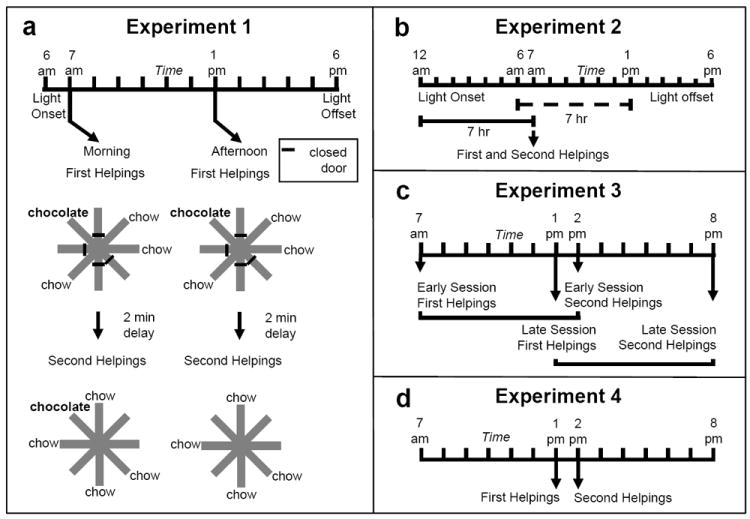Fig. 3.

Experimental design of Zhou and Crystal’s (2009) study. a. Design of Experiment 1. The morning or afternoon was randomly selected for presentation of first helpings (study phase; encoding) and second helpings (test phase; memory assessment) of food. An example of the accessible arms and flavors in study and test phases is shown. Chocolate or chow flavored pellets were available at four arms in the study phase (randomly selected). After a 2-min retention interval, chow-flavored pellets were available at previously inaccessible locations in the test phase. Chocolate replenished in the test phase conducted in the morning (7 a.m.) but not in the afternoon (1 p.m.) for half of the rats; these contingencies were reversed for the remaining rats (not shown). For each rat, one session (i.e., study and test phases) was conducted per day. b. Phase-shift design of Experiment 2. Light onset occurred at 12 a.m. (i.e., 6 hr earlier than in Experiment 1) and the study and test phases occurred at the time of a typical morning session. Note that 7 hr elapsed between light onset and the study-test sequence (solid horizontal line), which is comparable to the time between the typical light onset and a typical afternoon session (dashed horizontal line) in Experiment 1. The design of the experiment puts predictions for time-of-day and how-long-ago cues in conflict. Thus, a rat would be expected to behave as in its morning baseline (based on time of day) or as in its afternoon baseline (based on how long ago). c. Transfer-test design of Experiment 3. The time of day at which the study phase occurred was the same as in Experiment 1. The introduction of 7-hr retention intervals in Experiment 3 produced test phases that occurred at novel times of day. Early and late sessions had study times (but not test times) that corresponded to those in Experiment 1. The first two sessions in Experiment 3 consisted of one replenishment and one non-replenishment condition. An early or late session was randomly selected on subsequent days. Differential revisits to the chocolate location is expected if the rats were adjusting revisit rates based on the time of day at which the study episode occurred; revisit rates are expected to be equal in early and late sessions if the rats used time of day at which the test phase occurred. Study and test phases were as in Experiment 1, except that they were separated by 7-hr delays (shown by horizontal brackets). d. Conflict-test design of Experiment 4. The study and test phases occurred at 1 p.m. and 2 p.m., respectively. These times correspond to the typical time of day at which a late-session study phase and early-session test phase occurred in Experiment 3. The design of the experiment put predictions for time of day at study and time of day at test in conflict. A rat would be expected to behave as in its early-session, second-helpings baseline (based on test time of day) or as in its late-session, second-helpings baseline (based on study time of day). Reproduced with permission from Zhou, W., & Crystal, J. D. (2009). Evidence for remembering when events occurred in a rodent model of episodic memory. Proceedings of the National Academy of Sciences of the United States of America, 106, 9525-9529. © 2009 National Academy of Sciences, U.S.A.
